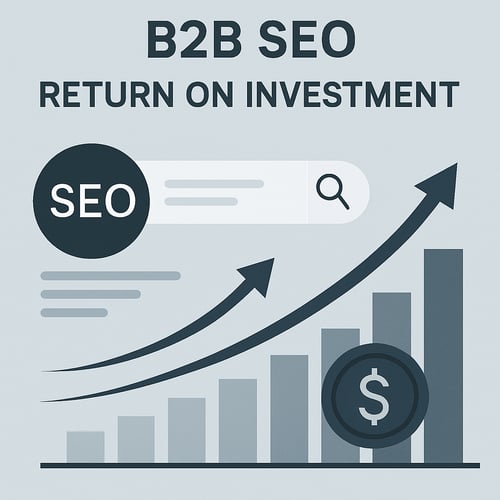If you’ve ever sat in a board meeting and been asked, “So, what’s SEO actually delivering for us?”, you’ll know the pressure of that moment. It’s not enough to show a graph of rising traffic or a list of keyword wins. Senior stakeholders want commercial answers: how is SEO filling the pipeline, accelerating deal velocity, and generating revenue?
The truth is, proving SEO ROI is tough. B2B sales cycles are long, journeys are rarely linear, and multiple touchpoints cloud the picture. But with the right framework and tools, you can show clear, practical evidence. This guide isn’t just theory — it’s designed to help you do the work: from the set-up checks you need, to the dashboards that make reporting board-ready.
Why Proving B2B SEO ROI Is So Difficult
SEO doesn’t exist in isolation. In B2B, decision-making involves teams, processes, and time. A single search might be the first step in a journey that takes months to convert. This complexity makes it hard to connect SEO activity with bottom-line results.
Traditional SEO reporting has focused on rankings, impressions, or clicks. Useful internally, yes, but these numbers don’t mean much to the board. What they want is evidence of business impact: pipeline growth, efficiency, and revenue contribution. To deliver that, you need to measure SEO across the full funnel and frame it in commercial terms.
The path forward is a blend of three things:
- Reliable tracking and data governance so you trust the numbers;
- A consistent funnel model everyone agrees on;
- Board-ready storytelling that translates technical signals into commercial outcomes.
This article walks you through each step in detail.
Pre-Funnel: Demonstrating Visibility with Search Tracking Tools
At this stage, your goal is to show the board how SEO is building visibility in your market. SEMrush and tracking tools provide practical ways to do this.
Set-up checklist
- Build a keyword set split by TOFU, MOFU, BOFU intent levels
- Add your top commercial keywords into a Position Tracking project to track their progress over time.
- Create branded vs. non‑branded keyword tags to show growth in new reach.
- Track SERP features (featured snippets, “people also ask”, video carousels) against your priority terms.
- Configure a weekly or monthly email report for visibility and ranking distribution so leadership sees steady movement.
Metrics to report
Treat these as early indicators, not end goals:
- Visibility % across intent clusters (e.g., “MOFU visibility up from 6% to 12% in Q2”).
- Ranking distribution (Top 3 / Top 10 / Top 20) to show depth of coverage.
- Share of voice vs. competitors on key topics.
- Featured snippet ownership/AI Overviews/Positions on money pages.
Quick win ideas:
- Target People Also Ask for two to three high-intent pages; add concise FAQ sections with schema.
- Identify one competitor gap (they rank, you don’t) per quarter and ship a surgical content piece for it.
Top of the Funnel (TOFU): Awareness & Lead Generation
Once prospects arrive, HubSpot or your CRM is where you capture the value. This is where SEO starts turning into leads — and where your data model begins to look commercial.
Set-up checklist
- Ensure the HubSpot tracking code is live on every page (including blog and microsites).
- Switch on the AI Referrals source bucket to capture traffic from platforms like ChatGPT and Perplexity.
- Establish UTM governance: a short internal guide for naming campaigns, mediums, and content.
- In GA4, define key events (e.g., generate_lead, file_download, view_promotion) and mark primary conversions.
- Do not try to track too many events and stick to lead generating or ROI driving activiities. If you need to track more, make sure your labelling is accurate so you can filter out based on your analysis needs.
Metrics to report
- Organic sessions (YoY and QoQ trends).
- New contacts created from Organic Search (HubSpot’s Source/Original source).
- Content performance: landing pages and blogs with view → CTA click → submission rates.
- Engagement signals: bounce rate equivalents, average engagement time, and scroll depth.
- AI referrals volume and behaviour — new audiences often behave differently; call that out.
TOFU playbook:
- Maintain a topic cluster map: pillar pages + supporting content, each with a defined CTA (subscribe, guide download, calculator).
- Review search intent alignment quarterly; retire or repurpose posts with traffic but poor engagement to better fit buyer needs.
Middle of the Funnel (MOFU): Engagement & Nurture
At MOFU, it’s about proving quality, not just volume. You’re answering: are SEO‑generated leads progressing toward revenue?
Set-up checklist
- Activate attribution reporting in HubSpot.
- Map nurture workflows so organic leads trigger the right sequences (by topic, persona, and intent).
- Create lifecycle stage definitions with sales (Lead → MQL → SQL → Opportunity) and document the rules.
Metrics to report
- Lead→MQL and MQL→SQL conversion rates from Organic.
- Assisted conversions where SEO contributed mid‑journey.
- Content influence: which MOFU pieces (comparisons, case studies, templates) show up most in assisted paths.
Practical tip: show progression, not just counts. A simple view — “Organic leads from April: 34% reached MQL; 18% became SQL by July” — demonstrates momentum the board understands.
MOFU playbook:
- Build comparison pages that map to known objections (“Vendor A vs. Vendor B”, “In‑house vs. outsourcing”).
- Create calculators, simple ROI tools or downloadable guides, measure conversion and assisted paths — these often pull prospects forward.
Bottom of the Funnel (BOFU): Pipeline & Revenue Impact
This is the moment your narrative lands. Tie SEO to pipeline and revenue, and the conversation changes.
Set-up checklist
- Ensure HubSpot deal boards are structured correctly. If sales hasn’t set them up, step in — or do it for them — so stages reflect real buying steps. Example suggested stages: Qualified → Discovery → Solution Fit → Proposal/Quote → Procurement → Closed Won/Lost.
- Enforce required fields at stage moves: deal amount, close date, buying committee role, primary contact.
- Implement call tracking (e.g., HubSpot Calling integrations, CallRail) — particularly when PPC and SEO run together.
- If automation is limited, agree with sales to collect manual deal close data weekly and attribute it back to contacts yourself.
Metrics to report
- Opportunities created from SEO‑sourced contacts (count and value).
- Closed‑won revenue influenced by SEO (first‑touch, last‑touch, multi‑touch).
- Pipeline velocity for SEO‑influenced deals vs. other channels.
- Customer Aquisition Costs by channel and blended CAC; show SEO’s cost efficiency relative to paid.
BOFU playbook:
- Add BOFU CTAs on high‑intent pages (pricing, implementation timelines, security/IT compliance).
The Tracking Backbone: Governance, QA, and Redundancy
Great reporting is built on boring but critical plumbing. Treat tracking like a product with owners, SLAs, and QA.
Governance
- Run a monthly data review: traffic integrity, conversion anomalies, deal stage hygiene.
QA
- Test key forms monthly (submit test leads; confirm they hit HubSpot with the correct source).
- Duplicate critical conversions in GA4 and HubSpot (belt and braces).
- Keep a backup view so you can recover trends if a tag breaks.
- Monitor 404s, redirect chains, and site speed — technical issues can torpedo attribution.
When sales ops isn’t ready
- Offer to co‑build the deal board, document the definitions, and train the team.
- Worst case, request weekly closed‑deal exports (CSV) from sales team and perform manual attribution to contacts/campaigns. Imperfect attribution is better than none.
Turning Data into a Board‑Ready Story
How you package your insight matters as much as the numbers themselves. The goal is clarity, not volume.
Anatomy of a winning board pack
- Headline slide — the quarter at a glance: SEO created X new contacts, Y opportunities, and £Z revenue.
- Funnel slide — TOFU → MOFU → BOFU with conversion rates and a one‑line narrative per stage.
- Efficiency slide — CAC by channel, pipeline velocity, and notable savings or gains.
- Risk & action slide — tracking fixes, content gaps, and next quarter’s bets.
- Appendix — detailed SEMrush and GA4 views for anyone who wants to dig in.
Storytelling cues that land with boards
- Lead with outcomes, follow with evidence, end with actions.
- Avoid jargon; translate technical wins into commercial terms (e.g., “Snippet ownership on ‘[topic]’ drove +18% demo requests”).
- Use consistent comparatives (YoY, QoQ) so trends are obvious.
- Call out what you stopped doing — efficiency is as compelling as growth.
Example: From Search to Signed Deal
Consider an HR tech SaaS provider targeting mid‑market HR leaders. In April, you publish an “Employee Onboarding Checklist (with ROI Calculator)” and align a small comparison hub around it.
- Before they reach your website (market visibility): SEMrush shows visibility on terms like “employee onboarding software” and “HR onboarding process” rising from 5% to 12% within eight weeks; you also win two People Also Ask placements.
- Website traffic and new leads: Data shows a 30% increase in organic sessions to the onboarding content; HubSpot reports 143 new contacts from organic search and 37 from AI referrals.
- Lead engagement and qualification: 48 people download the checklist; 20 enter an email sequence; 10 become sales‑qualified after reading a “Top Employee Onboarding Software” comparison.
- Opportunities and revenue: 5 opportunities open; 3 close in the quarter, totalling £126k ARR. Deals influenced by SEO move 15% faster through the pipeline, and cost per acquisition is 25% lower than paid search.
One slide with these numbers — plus a note that you’ll expand the comparison hub and refresh the checklist next quarter — creates a clear, board‑level story.
A simple overview like this example HubSpot sources report can help support your narrative

You can also provide very simple Source > Contact > Deal creation/amount connections to show pipeline creation


Common Pitfalls to Avoid
Even the best strategy can fail if tracking and reporting aren’t watertight. Avoid these mistakes:
- Reporting on rankings without connecting them to pipeline or revenue.
- Celebrating TOFU leads without showing progression into opportunities.
- Neglecting long‑tail, high‑intent keywords that convert.
- Letting tracking failures persist or not fixing broken tracking.
- Not prioritising analytics setup early.
- Skipping the basics: GA4 and HubSpot/CRM site‑wide are non‑negotiable.
- Failing to capture every touchpoint — risk losing credit for SEO to sales or events.
- Poor HubSpot deal board setup: if sales hasn’t done it right or at all, step in and fix it.
- Not collecting manual deal close data if automation or deals tracking isn’t in place. Some attribution beats no attribution!
Practical takeaway: treat tracking like insurance. Without it, you can’t prove your work — and if you can’t prove it, you won’t get the credit.
Making SEO ROI Crystal Clear
Your SEO strategy is only as strong as your ability to prove its impact. By setting up SEMrush for visibility, HubSpot (other CRMs are available!) for attribution and deal tracking, you can connect the dots from search to sales.
With the right set‑up, you can walk into the boardroom with confidence, showing not just clicks and rankings, but how SEO is driving leads, opportunities, and revenue. In short: a story of growth that speaks their language.
Want help setting up reporting that proves your impact? Book your free strategy session today.









